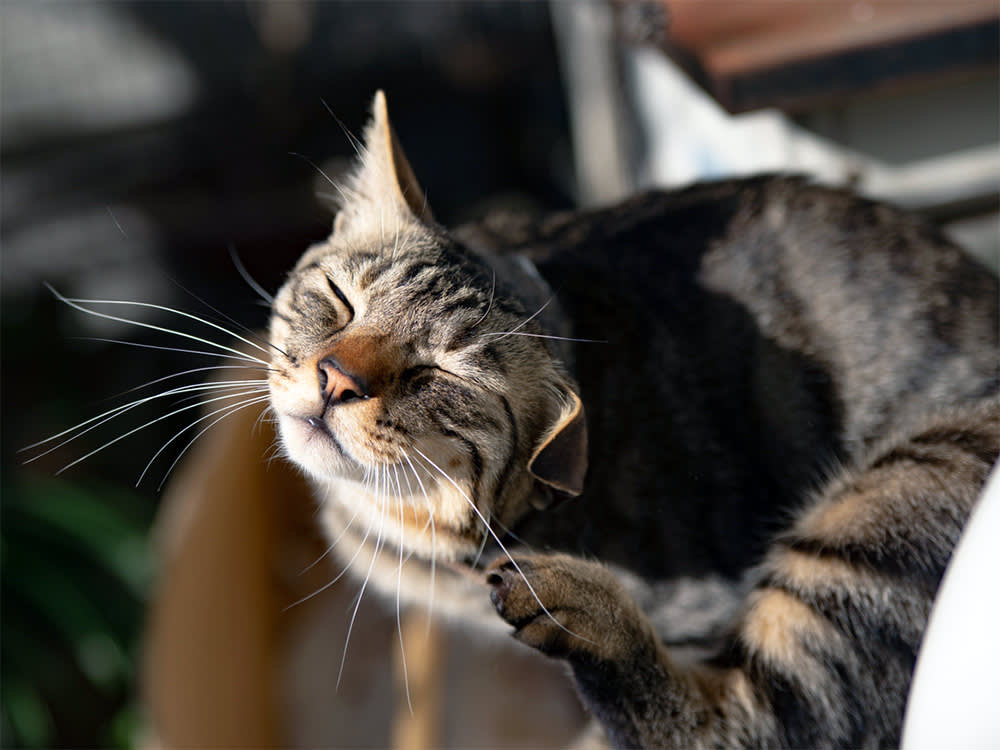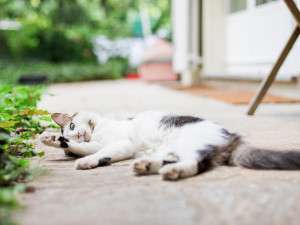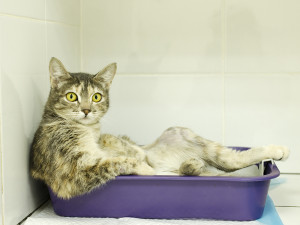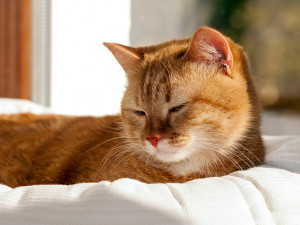Can Cats Get Lice?
The short answer: Yes. Here’s how you deal with it.

share article

Your pet wants you to read our newsletter. (Then give them a treat.)
In This Article:
How Do Cats Get Lice?opens in a new tab Symptoms of Lice in Catsopens in a new tab Dangers of Untreated Cat Liceopens in a new tab Effective Cat Lice Treatment opens in a new tabCan Humans Contract Cat Lice? opens in a new tabPreventing Lice Recurrenceopens in a new tab
Lice infestations in cats can result in skin irritation, hair loss, and secondary skin infections if not treated promptly. Cats can get lice through close contact with infested animals, sparking the need for topical treatments and thorough environmental cleaning to eliminate both lice and their eggs (nits).
How do cats get lice?
There are so many things that can make cats itchy, and unfortunately lice are one of them. Lice are tiny, wingless insects that live on a cat’s fur and feed on dead skin cells and blood. Lice can get on cats through direct contact with already infested cats, or indirectly through contact with contaminated objects like grooming supplies or bedding. Unlike fleasopens in a new tab, lice do not jump onto cats from the environment.
Infestation with lice, called pediculosis, is most commonly seen on cats who are young, malnourished, or immunocompromised. They are also seen on long-haired senior cats who have difficulty grooming themselves. Infestations most commonly occur on cats living in crowded, unsanitary spacesopens in a new tab, such as shelters, catteries, or multi-cat households. Lice on cats is more common in the winter than in the warmer months.
Although small, lice can be seen with the naked eye and are typically diagnosed by direct observation. Female lice lay eggs, called nits, that look like little white flakes on individual strands of fur. Adult lice can be seen moving around on the skin’s surface.
Types of lice cats can contract
Lice are species specific, meaning cats get lice from other cats, dogs get lice from other dogs, and so on. Lice come in two major categories based on their feeding habits: chewing and sucking. Cats get infected by Felicola subrostratus, a type of chewing louse. The biting triggers major skin irritation in infested cats.
Symptoms of lice in cats
Cats with lice will exhibit many of the same symptoms as cats with other types of skin parasites. The tiny pest’s constant gnawing causes intense itching and irritationopens in a new tab, making a cat miserable — so miserable that restlessness is one of the most common symptoms. Symptoms of lice infestations in cats include:
Restlessness
Scratching
Excessive grooming
Skin abrasions and scabs
White specks on the fur
Matted fur
Dangers of untreated cat lice
While a lice infestation by itself isn’t usually life-threatening for cats, leaving it untreated can lead to several serious complications. Potential risks of an unchecked lice infestation include:
Anemia: Cats with severe lice infestations are at risk of developing anemia (low red blood cell count). Anemia can lead to lethargy and weakness, and can become life-threatening in extremely young or old cats.
Skin infections: Cats with lice scratch — a lot. Constant scratching and biting can lead to open wounds, creating an entry point for bacteria. Skin infectionsopens in a new tab can cause redness, swelling, bad odor, and pain. Widespread skin infections can make cats feel sick.
Poor quality of life: Persistent itching and discomfort can seriously impact a cat’s quality of life. Cats can become anxious and agitated. Hearing non-stop scratching and licking is no fun for cat parents either.
Continued transmission: Left untreated, a cat with lice will infect other cats in the home, creating a cycle of infestations.
Effective cat lice treatment
While no cat parent wants to find out that their kitty has lice, the good news is that lice are pretty easy to treat. A cat can be free of lice within a week or so by following simple steps.
Consult a veterinarian.
Your vet will confirm the diagnosis and check for other skin parasites or secondary skin infections that may require treatment. Your vet can also guide you on options that will kill the lice safely.
Perform necessary grooming.
A flea comb can help physically remove some of the adult lice and nits, but combing won’t remove all lice, and the ones left behind will keep the cycle going. Cats with unkempt fur should be bathedopens in a new tab and brushed as needed. If your cat’s fur is long and matted, your vet may recommend clipping the fur first to ensure products can reach the skin.
Apply a vet-approved medication.
There are several effective formulations for treating cat lice, including shampoos, sprays, and spot-on treatments. Many products are effective against other parasites like fleas and ticksopens in a new tab. Some treatments may need to be repeated in one to two weeks to kill newly hatched lice.
Never apply an insecticide to your cat without getting veterinary approval. Some products, like those that contain permethrinopens in a new tab or pyrethrin, can be toxic to cats.
Clean the environment.
Vacuum thoroughly, clean commonly used surfaces, and wash or replace all bedding. Disinfect all grooming equipment (flea combs, brushes, clippers, etc) between pets and after each use.
Treat all cats in the home.
Even if lice are found on only one cat, all cats in the household should be treated to prevent recurrence.
Can humans contract lice from cats?
Cat lice are not zoonotic, so you can’t get lice from cats. If you happen to be unlucky enough to be dealing with your own head lice infestation, rest assured that you cannot give your cat human lice, either. Feel free to snuggle upopens in a new tab.
While you and your cat can’t share infestations, lice can carry infectious organisms like Bartonella bacteriaopens in a new tab. These can cause infections like cat-scratch fever, but transmission through lice is rare.
Preventing lice recurrence
To prevent lice recurrence, cat parents must follow the recommended treatment plan, perform regular preventive measures, and maintain good hygiene practices. After treatment, monitor all cats closely for signs for recurrence like excessive scratching. Inspect your cat’s fur for adult lice or nits. If there is any indication that a lice infestation has recurred, consult your veterinarian.
FAQs (People also ask):
How can you tell if your cat has lice?
Cats parents can be clued into their cat having a lice infestation if their cat is excessively scratching or grooming. Inspection of the fur may reveal adult lice or lice eggs (nits) near the base of the fur.
Can you get lice from cats?
You cannot get lice from your cat. Lice are species specific, meaning cats can only give lice to other cats. Similarly, people can only give lice to other people.
How do indoor cats get lice?
Cats get lice by living in close quarters with other cats who are infested with lice. Common environments for lice infestation include animal shelters, catteries, and multi-cat households.
Can cats get lice from dogs?
In general, cats cannot get a lice infestation from dogs. There have been rare instances in which dog lice have been found on unhealthy stray kittens that lived in close proximity to infested dogs.
References:

Dr. Alycia Washington, DVM, MS
Alycia Washington, DVM, is a small animal emergency veterinarian based in North Carolina. She works as a relief veterinarianopens in a new tab and provides services to numerous emergency and specialty hospitals. Dr. Washington is also a children’s book author and freelance writer with a focus on veterinary medicine. She has a special fondness for turtles, honey bees, and penguins — none of which she treats. In her free time, Dr. Washington enjoys travel, good food, and good enough coffee.
Related articles
![Brown Labrador lifting front leg]() opens in a new tab
opens in a new tabHow to Get a Head Start on Your Pet’s Health
Spot lumps, limps, and lethargy early on.
![A young woman walks with her dog in a winter park.]() opens in a new tab
opens in a new tabShould You Use Flea and Tick Prevention for Your Pet in the Winter?
You’ve got good ol’ climate change to thank for this answer.
![Cozy at home with tabby cat, woman with her pet on sofa at home in evening.]() opens in a new tab
opens in a new tabShould You Give Your Pet Heartworm Prevention in the Winter?
Here’s why it’s best to stay on top of things, even when the temps are low.
![Cozy at home with tabby cat, woman with her pet on sofa at home in evening.]() opens in a new tab
opens in a new tabShould You Give Your Pet Heartworm Prevention in the Winter?
Here’s why it’s best to stay on top of things, even when the temps are low.
![A shorthair cat itching.]() opens in a new tab
opens in a new tabAdvantage vs. Advantix: Not the Same Thing
Don’t make this dangerous mistake when picking out flea prevention products.
![Red cat with squinted eyes laying in a basket closeup]() opens in a new tab
opens in a new tab6 Ways Your Cat Could Tell You They Are in Pain
Here are all the way your kitty is trying to tell you they’re hurting.








